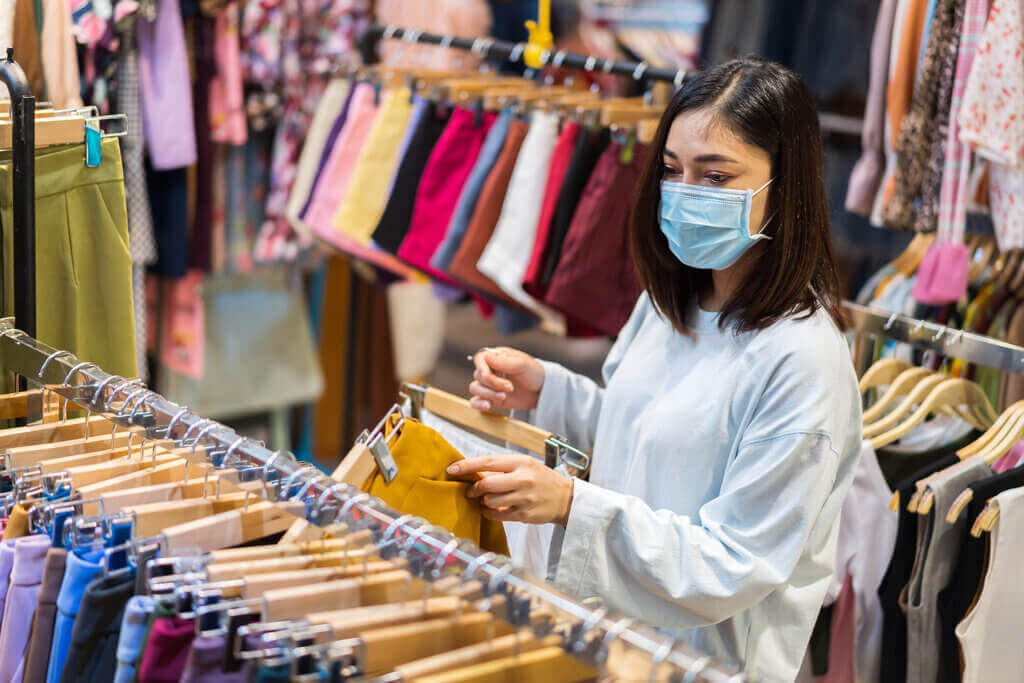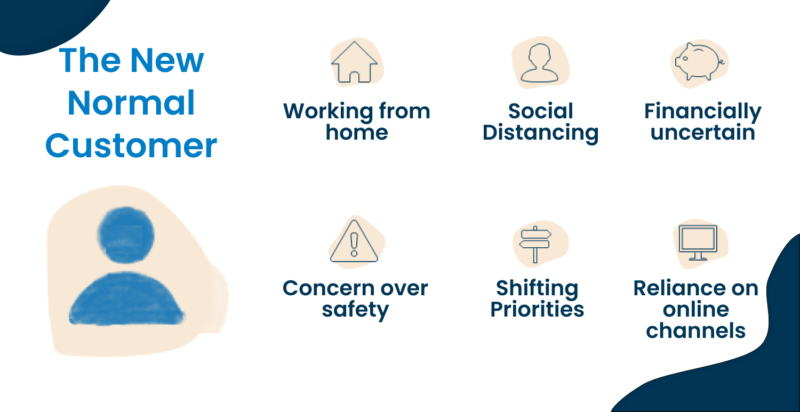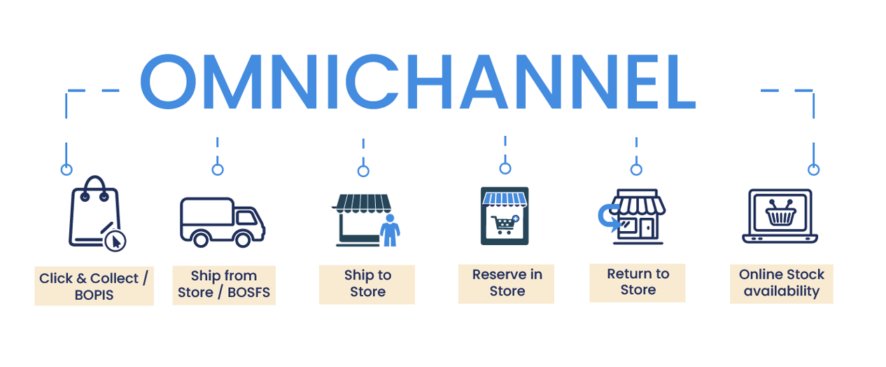COVID-19 has caused massive disruption to retail. So, what do retailers need to do to not only survive, but to excel in this new normal environment?
5 Priorities for Retailers Looking to Thrive in the New Normal

1- Adapting to the digital-first world
COVID-19 caused a huge increase in the role digital technology plays in our lives. Even for the already tech-savvy, work habits, social lives, exercise, and entertainment were all transformed into digital-first activities. Many of these trends existed before, but the pandemic accelerated this change by forcing many people to rely on digital channels and services more than ever.
The same is true for retail – online shopping and social media marketing are not new but have grown exponentially in the new normal, as customers stay at home and spend more time online. This means that, for all retail industries bar perhaps food, online channels have taken centre stage.
More than ever, customers are not only buying online, but they are also shopping online. What’s the difference? If we think of buying as the purchasing of a product, where the price is the primary factor, shopping is everything else – the experience, and the browsing and sampling of products, and ultimately the purchase decision itself. Traditionally e-commerce has always great for the former, but for actually browsing and discovering products its never been as good as in real-life. This is changing though, with digital technology like augmented reality (AR) allowing the customer to virtually try on products or see what they look like in true-to-life scale.
So, to adapt to this increasingly digital way of shopping Multichannel retailers or even pure-play brick and mortar retailers need to make more of an effort to reach their customers online. In the new normal, online is the focal point of the journey.
A webshop is one thing, but retailers need to make more of an effort to reach and meet their customers online. This means not only bringing products to customers with online and social media advertising but taking the entire brand experience online by engaging with customers on social channels and adapting to digital forms of experiences.
2- Understanding the new normal customer
While adapting to meet customers in the new environment is crucial, its just as important to really understand who the new normal customer is.
While they are of course the same people as before, habits and circumstances have completely changed – what customers want, and their priorities have completely shifted. As a result of this shift brand loyalty for many has gone back to square one, with more consumers changing and trying new brands this year than ever before. Whilst this puts retailers under even more pressure, it also presents an opportunity to attract and impress completely new customers.
But what has caused this shift, and who is the new normal customer?

3- Embracing Omnichannel
Omnichannel retail, offering an integrated and consistent experience between online and offline channels, is not a new concept in the industry. But much like online shopping, omnichannel offerings have become exponentially more valuable since COVID-19. With the balance between digital and physical retail shifting, retailers offering a strong omnichannel experience are in a far stronger position than those who do not. Simply having an eCommerce site on top of stores (multi-channel) will put retailers in a better position as pure-play brick-and-mortar retailers, as they can take advantage of the increase in online shoppers and still be able to deliver to loyal customers who can no longer shop in-store. However, with pure plays being rarer than ever this is simply not enough anymore.
Omnichannel goes beyond this, by seamlessly integrating online and offline channels, allowing for offerings like click and collect (Buy-online-pickup-in-store/BOPIS), return-to-store and ship-from-store (BOSFS). The benefits of such a strategy go both ways. Customers get access to more available stock and convenient purchasing options; they can collect from stores (BOPIS and curbside) or can get products shipped straight to their homes. For retailers, omnichannel allows you to leverage stores as miniature distribution centres, cutting down on shipping costs while keeping struggling stores busy. With click-and-collect, the benefits are similar and allow stores to benefit from and serve online customers, Curbside pickup is a new type of click-and-collect that has become hugely popular since the pandemic as it keeps customers feeling safe and allows for social distancing.

4- Optimising costs
As much as positioning for the new normal is vital for success going forward, the unfortunate fact is many brands will be struggling with the financial impact of COVID-19. As a result, optimising costs across the board is vital for retailers trying to weather the storm and stay open long enough to adapt to the new normal. Retailers feeling the worst of the financial strain of COVID will be forced to rethink their footprint in order to survive. Closing down stores and losing staff is always a last resort, but one the vast majority have been faced with this year, as less profitable locations are surrendered to ensure the survival of the brand. But what about retailers in stronger positions, those looking to optimise their costs in the long-term without hampering themselves or their customers?
For stores, improving the efficiency of in-store processes across the board can reduce operating costs in the long-term. Processes like inventory management (Processing inbound shipments, stocktakes, replenishment) point-of-sale and loss-prevention can all be streamlined with cost-effective technology. The focus should not be to manage these things more cheaply but to manage them more effectively. To use the point of inventory management, Detego has repeatedly found that increasing stock accuracy in our customer’s stores from an average of 70% to 98% means stores can run with far leaner inventories. If you do this at scale across your entire store network, it’s possible to reduce working capital by 10-15%.
In the supply chain too, there are huge opportunities to run more efficiently and reduce costs. The cost of handling and processing the flow of goods throughout the supply chain, particularly in Distribution centres, can be reduced by investing in technology like RFID and warehouse automation which reduces labour and handling costs. By improving the accuracy and visibility of their supply chain retailers can also reduce chargebacks and other costs associated with shipping mistakes. Finally, there are huge savings to be made by achieving full supply chain visibility – knowing exactly where individual items are (and where they’ve come from) allows retailers to fully optimise their supply chains reducing losses from shrinkage, counterfeits, and grey market goods.
5- Re-thinking data and digital for a post-COVID world
Retail, particularly sectors like fashion and beauty, has been facing the need for digital transformation for a few years. The rise of online channels, digital-first consumers, and the continuous advance of technology has meant brands can’t afford to stand still when it comes to how they run their businesses. Whilst understandably many brands are focusing on staying afloat in the immediate aftermath, COVID-19 did not stop this need for transformation – it accelerated it. Now there is a greater need than ever to ensure brands have the data and IT infrastructure to react to change and make the right decisions. With the sudden shift in the industry caused by the pandemic, retailers may need to revisit digital and analytics priorities but adapt them to a post-COVID world.
In times of uncertainty, accurate data, improved visibility, and effective analytics can make all the difference. We’ve already discussed how retailers with the right infrastructure (meaning accurate visibility over their products) are profiting from their omnichannel offerings. But having a mature tech stack can unlock tonnes of value that will be vital in the new normal. For example, item-level visibility and granular data in the supply chain not only allows for greater agility when dealing with supply and fulfilment but the data can be used for advanced analytics like demand prediction and inventory optimisation across store networks.



